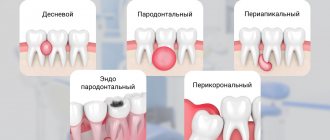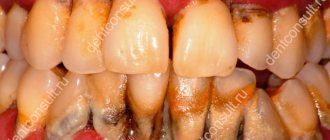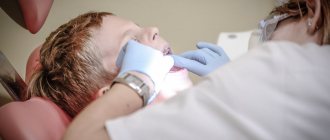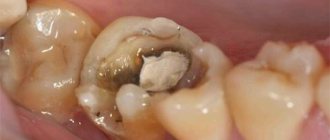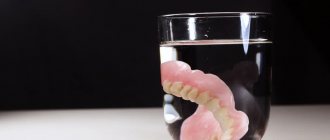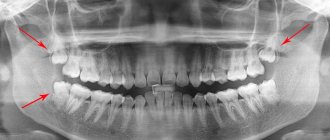Imagine a mouth with rotten teeth and the smell that comes from them, it is not difficult to guess how repulsive and unpleasant a person with such a problem looks. Bad teeth greatly spoil the impression of a person’s appearance, prevent him from communicating normally with other people, and disrupt his psychological state.
However, this problem is not only aesthetic. Dentists warn that rotten teeth cause arthrosis, polyarthritis, and disrupt the condition of the skeletal system. The products of decay and the microbes that provoke them are carried throughout the body with saliva and blood. A person begins to have problems with organs that, at first glance, have nothing to do with teeth. The infection gradually affects the bone tissue and can reach the brain.
What happens if you ignore the body’s signals, drown out the pain with pills, mask the smell with air fresheners? It may be possible to hide the negative symptoms for a while. However, as they accumulate, they will lead to the appearance of other and not only dental problems.
Causes of tooth decay. How to stop him?
To provide adequate treatment, the doctor must first determine the cause of the disease. Otherwise, the measures may turn out to be useless, the process will continue to develop. The causes of tooth decay are external and internal factors. Despite the fact that enamel is considered one of the most durable materials in the body, under unfavorable conditions it quickly deteriorates. As a result, microbes gain unhindered access to the inner, less protected part of the tooth.
To cope with this problem at the initial stage, one visit to the dentist is usually enough. He clears the cavity of affected tissue and closes it with a filling. However, simple neglect of their health and fear of the dental office make people postpone the visit. The result is deterioration of the teeth and their loss.
How can a dentist help?
Depending on the degree of tooth decay, stage and causes of fragility, as well as taking into account the natural appearance of the dentition, the doctor selects treatment methods:
- Installation of fillings - used when the tooth has crumbled slightly and it is possible to restore it completely.
- Veneers - ceramic onlays will be the solution if the front tooth has crumbled and it is impossible to restore it to its original aesthetic state.
- Inlays – if a chewing tooth is destroyed by 50%, inlays will help; their advantage is that they are more durable and airtight than fillings and can withstand loads well.
- Crowns – if the crown part of the tooth is completely destroyed, prosthetics with crowns are necessary.
- Removal and implantation - if the tooth is crumbled and the tooth root is also almost destroyed, it is removed, and then implantation is carried out and a crown is put on.
Our dentist will select a method based on the individual characteristics of the teeth, their location and condition. It is worth noting that regular visits to our clinic reduce the risk of tooth decay. Visit your dentist at least once a year for a professional examination to avoid serious diseases and complex long-term treatment for them.
When is a person to blame for having bad teeth?
Experts identify a number of causes of tooth decay, for which the patient himself is to blame. Knowing them, you can take timely measures to prevent the development of the disease. These reasons include:
- Smoking. Components released from tobacco disrupt metabolic processes in dental tissues. Due to this, their ability to resist adverse effects is sharply reduced.
- Alcohol, drugs. They negatively affect the functioning of the entire body, impair its protective functions and ability to recover.
- Poor nutrition. Lack of minerals and vitamins in food leads to weakening of the enamel. An excess of sweets, sour fruits, and berries contributes to the destruction of enamel.
- Unhealthy Lifestyle. Lack of physical activity, constant presence in dusty rooms, abuse of fatty, fried foods reduces the body's protective functions.
In addition, lack of or improper oral hygiene contributes to the formation of plaque. It becomes a source of food for microorganisms that gradually destroy teeth.
What will help strengthen the enamel?
- Professional oral hygiene. It will not only get rid of tartar and deposits, but also significantly reduce microbial activity in the mouth.
- Enamel remineralization or fluoridation. The enamel will receive additional nutrition, which will strengthen its structure.
- Taking multivitamins and calcium, a balanced diet.
- Hormonal therapy.
Negative factors beyond the patient's control
If a person does not smoke, engages in debate, and watches his diet, why do his teeth begin to rot? There may be several reasons for this:
- Bad ecology. Polluted air, poor quality water, an excess of some and a lack of other important components. Fluoride deficiency is often cited as the cause of dental problems.
- Heredity. If the parents had bad teeth or the mother did not visit the dentist during pregnancy, children often experience similar problems.
- Physiological features. Hormonal imbalance in adolescents during the growth period, in pregnant and lactating mothers.
Tooth decay is often a consequence of other diseases. Problems with periodontal tissues - gingivitis, periodontitis, periodontal disease - lead to the development of caries and cause tooth loss. If a purulent cyst forms near the root, the infection quickly spreads to the tooth. Often the deterioration of teeth is caused by diseases of the stomach, intestines, and thyroid gland.
Teeth began to crumble during pregnancy
For the development of the fetus, calcium is necessary, which the child receives from the body of the expectant mother. A woman experiences a deficiency if she does not eat well and does not take it additionally in the form of supplements or mineral complexes. Teeth may be destroyed, which occurs quite often in this “interesting position.”
The next factor influencing the weakness of dental tissue may be a hormonal surge during pregnancy and the nervousness of the mother.
Necessary:
- take care of a sufficient supply of calcium
in the body, because it also affects the development of the skeletal system (including the rudiments of teeth) of the unborn child. Eat a balanced diet, if necessary, take active supplements with calcium and vitamin D prescribed by your doctor; - don’t be nervous,
and walk more - be observed
during pregnancy by a gynecologist, dentist, or other doctors, if indicated.
Teeth can crumble not only during pregnancy, but also during lactation. With mother's milk, calcium is transferred to the baby.
Characteristic symptoms and stages of disease development
Dental problems manifest themselves in different ways. It depends on the degree of damage, the sensitivity of the body, and the number of problem areas. Tooth decay does not occur in just one day.
Dentists distinguish several characteristic stages, which are characterized by certain symptoms:
- Unpleasant smell. At first it is not too noticeable. Gradually, even during a conversation, the interlocutor feels a putrid “aroma”. Its source is pathogenic bacteria. They inhabit plaque that forms at the point of contact between the gum and tooth.
- Stains on the enamel. This is the next stage of the disease, when the damage spreads deeper and damages the enamel.
- Black areas. If they are located on the root, it is very difficult to notice them. To clarify the extent of the damage, an x-ray is taken.
- Formation of the cavity. A cavity forms in place of the black spot. Through it, food debris gets to the inside of the tooth. The tooth actively “signals” about the problem with painful sensations, reaction to hot and cold.
- Pulpitis develops. By not consulting a doctor in time, the patient allows inflammation to reach the pulp. Soft tissues containing blood vessels and nerves undergo rotting. It is accompanied by sharp, unbearable pain.
The decay process ends in different ways. If it starts from the top of the tooth, it gradually spreads to the root. After the nerve dies, the pain intensity decreases. If decay affects the root first, the tooth may fall out or have to be removed.
Habits that ruin your teeth every day
| Regular sweet snacks form plaque and destroy enamel |
| Biting foreign objects creates cracks |
| Bruxism: Teeth grinding at night causes tooth wear |
| Large amounts of citrus fruits: acid destroys enamel |
| Drinks with bright pigments stain tooth enamel |
| Improper brushing of teeth destroys enamel and injures gums |
| Frequent whitening with folk remedies destroys enamel and increases sensitivity |
Why do teeth rot at the gums?
Caries near the gums and on visible parts of the tooth are no different.
The reasons for its occurrence are the same, but near the gums it is more difficult to identify and treat the disease. Therefore, patients usually consult a doctor at the stage of progressive pulpitis. Timely detection helps prevent the development of caries in the gingival region. To do this, you need to periodically visit the dentist, who will correctly assess the condition of the enamel and detect the development of caries in time. Experts call gum disease a common cause of its occurrence. Food debris that accumulates in the gum pocket promotes the development of bacteria. In addition, the disease can be caused by an incorrectly installed crown, poor hygiene, or changes in the composition of saliva.
How to get rid of the problem, solution methods
The dentist will decide how to stop tooth decay after identifying the cause. If treatment by other doctors is necessary, then in parallel it is already possible to begin the restoration of dental units.
Dental restoration methods:
- filling.
Installing a filling in place of the missing piece of tissue. If the carious cavity is large enough and the walls are fragile, then an inlay with a composite material may be indicated; - veneers.
If there is a chip or crack in the front teeth of the frontal area, a thin ceramic overlay will correct the situation, hiding all the defects; - crowns
When the crown of a tooth is severely damaged, the doctor may recommend installing an artificial one from the selected material. Most often these are metal ceramics, ceramics, zirconium dioxide. It is important what condition the gums are in; - remineralization.
Restoring the normal balance of vitamins in the enamel structure. A special composition is applied to the surface of the teeth for several minutes. The tissue is saturated, enriched with calcium, fluoride, becomes stronger and can even remove caries at the chalk spot stage; - fluoridation.
Fluoride-containing pastes nourish the enamel. Fluorine is responsible for crystalline calcium compounds. Fluoride varnish seals dentinal tubules, strengthening teeth; - taking active
calcium and vitamin D
The ecological situation of the region of residence is one of the causes of dental health pathologies. The quality of air, water and food is far from ideal. Replenish the deficiency with complex supplements, spend your weekends in nature. Love organic farm products.
What to do with a tooth that has rotted to the root?
If the root has rotted and treatment measures do not produce results, the tooth has to be removed. Loss of the upper part leads to the development of pathologies:
- the appearance of a cyst at the root apex;
- fracture or dislocation of the root;
- injury to the gums from a splinter;
- periodontal diseases.
A rotten root becomes a source of infection that spreads to nearby tissues.
In any case, the doctor chooses the treatment. If there is a high probability of negative consequences, removal will be carried out. To avoid this, it is recommended not to skip periodic dental checkups.
Necessary prevention
Beyond heredity, preventative measures to maintain dental health are everyone’s first priority. No matter how smooth and snow-white the teeth are, insufficient hygienic care leads to tooth loss.
When teeth are forming in the womb, the following are likely to occur:
- hypoplasia (underdevelopment) of enamel;
- hyperplasia (excessive formation) of enamel;
- fluorosis (intoxication with fluoride salts);
- drug-induced tissue development disorders;
- hereditary disorders.
These pathologies are predetermined, because the lifestyle of a pregnant woman leads to their appearance. In all other cases, preventive measures and hygiene will keep teeth healthy, even with bad hereditary factors.
A child’s teeth are rotting: to treat or not to treat?
Rotten teeth are in most cases a problem for adults. However, this process can affect baby teeth. Moreover, the path from the appearance of a small spot to a severe stage passes very quickly. The reasons for this phenomenon are the same as in adults. At the same time, we can identify characteristic factors that have a negative impact on children’s teeth:
- excessive love for sweets;
- insufficient oral hygiene;
- mother's dental problems during pregnancy.
It is impossible to stop rotting at home. You must contact your dentist immediately.
Features of treatment of anterior teeth
The four incisors in the center of the upper and lower jaws are the front teeth. They are capricious, with a thin layer of enamel and dentin, caries strikes them quickly. Therefore, at the slightest discomfort, run to the dentist!
The front teeth are a very important area not only for the patient, but also for the dentist. They are always visible; everyone will notice errors in treatment. Incisors require jewelry precision from the dentist; the enamel is thinner, so the patient experiences more pain. Don’t forget about aesthetics - an incorrectly chosen filling color or poor degree of transparency will ruin the entire treatment.
The smile area requires special care. Observation should be made for crowded front teeth that overlap each other and are too large. The lack of vitamins in the body primarily affects the incisors - vitamin deficiency does not cost anything to undermine the already thin enamel. Food that often gets stuck in the interdental spaces warns of impending caries. It is better not to delay your visit to the clinic where front teeth are treated in Moscow: at the very beginning, caries is treated without the use of a drill.
Caries on baby teeth
As a result of long-term research, scientists were able to identify the main cause of caries in baby teeth. It becomes: microorganisms transmitted to the child from the mother. Streptococcus gets to the baby through a kiss, through a pacifier licked by the mother, or shared cutlery. Microbes come from other people through these same routes. When teething, babies are especially vulnerable to streptococcus. In addition, lack of oral hygiene, poor diet, and the composition of saliva have a negative impact.
Dentists point out that regular use of baby formulas from a bottle with a high carbohydrate content creates ideal conditions for the development of bacteria. Getting your baby used to a cup and rinsing his mouth after eating helps reduce their negative effects.
previous post
Pin in a tooth: types and advantages of design
next post
How much does front tooth treatment cost?
The cost of treatment depends on the method and materials used. When it comes to the smile area, it is better not to skimp. In this case, prudent patients often have to remember the stingy man who pays twice. Choosing cheap materials often leads to aesthetic flaws, disappointment and repeated treatments.
As a rule, prices for treatment of front teeth in Moscow start from 2,000 rubles. For example, the cost of caries treatment without drilling ranges from 2,000 to 5,500 rubles. A light seal costs from 1,500 to 10,000 rubles. The price tag for splinting loose front teeth starts from 2,800 to 7,000 rubles. Removing a cyst will cost 7,000 - 37,000 rubles, granulomas - from 5,000 to 40,000. A dental inlay will cost from 5,200 to 20,000 rubles. Prices for veneers start from 5,000 rubles, lumineers - from 40,000. The range of prices for zirconium crowns is from 13,500 to 40,000, ceramic - from 17,000 to 57,000. Clasp prosthesis will cost from 29,000 to 73,000, dental implantation - from 30,000 to 120,000 and more.
The most dangerous complications of caries
- Pulpitis
A sign of pulpitis is a sharp, acute pain radiating to the ear or jaw. It can occur at any time without connection with any specific stimuli. It is not always possible to determine which tooth is causing it.
- Periodontitis
The disease develops due to the lack of treatment for pulpitis. The problem is localized at the apex of the root of the affected tooth.
Stages of caries
- The appearance of a stain - the enamel changes color. It's still hard, but the process is already underway. A doctor can detect the spot. It is important to come for a preventive examination on time.
- Superficial caries – demineralization of enamel. The appearance of discomfort when eating hot, cold or sweet foods. At this stage, the enamel can be strengthened.
- Damage to dentin. Painful sensations increase and become longer lasting. The carious area grows and deepens. A cavity appears in the tooth in which food particles remain. A favorable environment is created for the growth of bacteria. Pulpitis may develop.
- Deep caries. Pulp degeneration occurs and periodontitis occurs. You can lose a tooth or undergo nerve removal. At this stage, the patient experiences severe pain.
Which ones are better for chewing teeth?
Implantation of chewing teeth
– the most effective and reliable recovery option. An implant is an artificial root that will take on the entire load when chewing, will not become loose, will not fall out, and will not lead to the loss of neighboring teeth. Implants are long-lasting, you can install a durable metal-ceramic crown on them, and even after the service life of the prosthesis expires, the implant does not need to be replaced.
However, implantation of back teeth may become impossible if a large amount of time has passed since the loss, due to loss of bone tissue. It is possible to perform bone augmentation surgery (sinus lift), but this will significantly increase the time and cost of implantation. In addition, even a sinus lift is not possible in all cases, and each case must be considered individually.
Removable prosthetics
- the simplest and most accessible method. Both soft nylon dentures and plate removable dentures can be used as removable dentures.
Nylon prosthesis
feels more comfortable in the mouth; in case of a terminal defect, it can be attached both to adjacent teeth and to the gum. However, such a prosthesis lasts for a maximum of 5-7 years, and towards the end of its service life it begins to fit worse in the mouth, which is why the patient will need to use additional fixing creams and ointments.
Lamellar prosthesis
(plastic, acrylic or acry-free) - cheaper and more accessible than nylon, but hard and less comfortable in the mouth.
Clasp prosthetics
(in which the prosthesis will be attached to adjacent teeth with hooks or clasps) is possible only in the case of an end defect on both sides of the dentition. This is a more comfortable method of conditionally removable prosthetics, convenient, evenly distributing the load and securely fixed to the teeth. However, if we talk about the loss of chewing teeth, such a prosthesis will have to be attached to the supporting front teeth, which means that the hooks can be noticeable when smiling and talking, which reduces the aesthetics of such a prosthesis. If you take clasp dentures with clasps, you will have to grind down the patient’s neighboring, healthy and intact teeth for fastening, put crowns on them, and only attach clasps to these crowns.
As a result, the most reliable, effective and, ultimately, profitable method of restoring chewing teeth is implant prosthetics. Taking into account the variety of implants
, you can choose an option that suits the patient both in price and quality.
However, each case must be considered individually. An orthopedic specialist will determine possible options for prosthetics of a chewing tooth to make your smile full and attractive. Each specific situation has a specific prosthetic plan.
You can make an appointment at the As-Stom clinic by phone 597-05-05
or using the online application form on the website.
What is an end defect?
Losing the attractiveness and integrity of a smile is a real disaster for most people. But, unfortunately, there are people for whom the loss of a tooth or even teeth is absolutely no reason to see a dentist. Especially when it comes to back molars.
Loss of the back teeth of the upper or lower jaw is called an end defect
– and this is truly one of the most important and complex problems in prosthetic dentistry. First of all, due to the enormous functional load that the posterior (chewing) teeth bear.
“Just think, my back teeth are falling out! You still can’t see them when you smile!”
Of course, this is a misconception. After all, the point is far from being about the beauty of a smile, but about a functional disorder of the dental system, which provokes many serious dental diseases. The absence of back teeth will sooner or later trigger a process of negative consequences in relation to both the central teeth and the smile line.


